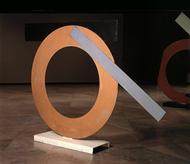
|
David Smith (artist) American, 1906 - 1965 Circle I, 1962 painted steel overall: 200.6 x 273.6 x 45.7 cm (79 x 107 11/16 x 18 in.) gross weight: 500 lb. Ailsa Mellon Bruce Fund 1977.60.1 |
Object 7 of 8
America's leading modern sculptor, David Smith belongs to the generation of abstract expressionist artists that included Jackson Pollock and Willem de Kooning. In 1934 Smith set up a studio at Terminal Iron Works, a machinist shop in Brooklyn, where he translated the industrial materials and methods of that trade into his art. Inspired by the welded sculptures of Pablo Picasso and Julio Gonzales from the late 1920s, Smith incorporated machine parts, scrap metal and found objects into his innovative and remarkably diverse structures.
Smith only adopted the circle as a single compositional focus in the early sixties, perhaps in response to the target paintings then being created by his friend Kenneth Noland. Although the Three Circles in the collection of the National Gallery of Art are obviously related, they are subtly differentiated in color, the size of the interior diameter, and the geometric shapes that have been welded to either side of the circle. Typically, the polychromed surfaces are sensitively treated; one can easily trace the path of the artist's brush. Smith probably intended the circles as a kind of triptych from their inception, but the definitive arrangement of the group was achieved only when he moved the circles about in the fields of his studio at Bolton Landing, eventually aligning them so that they could be viewed concentrically.
Related Works: Circle II; Circle III
| « | back to gallery | » | continue tour |


